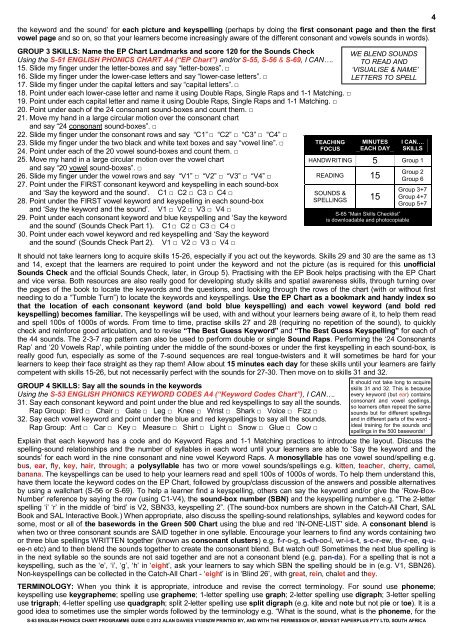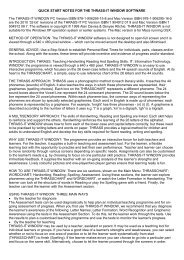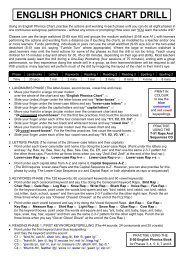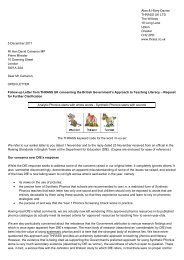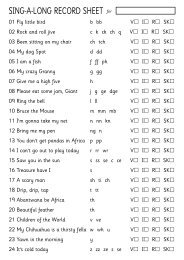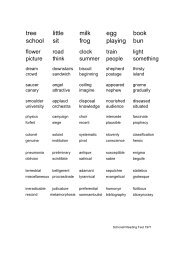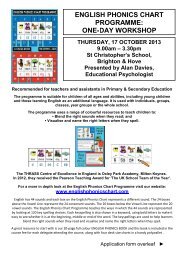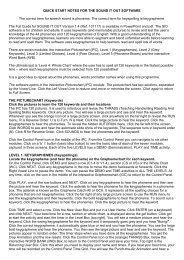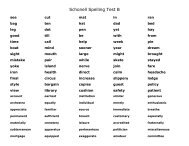English Phonics Chart Programme Guide - THRASS
English Phonics Chart Programme Guide - THRASS
English Phonics Chart Programme Guide - THRASS
You also want an ePaper? Increase the reach of your titles
YUMPU automatically turns print PDFs into web optimized ePapers that Google loves.
4<br />
the keyword and the sound’ for each picture and keyspelling (perhaps by doing the first consonant page and then the first<br />
vowel page and so on, so that your learners become increasingly aware of the different consonant and vowels sounds in words).<br />
GROUP 3 SKILLS: Name the EP <strong>Chart</strong> Landmarks and score 120 for the Sounds Check<br />
Using the S-51 ENGLISH PHONICS CHART A4 (“EP <strong>Chart</strong>”) and/or S-55, S-56 & S-69, I CAN….<br />
15. Slide my finger under the letter-boxes and say “letter-boxes”. □<br />
16. Slide my finger under the lower-case letters and say “lower-case letters”. □<br />
17. Slide my finger under the capital letters and say “capital letters”. □<br />
18. Point under each lower-case letter and name it using Double Raps, Single Raps and 1-1 Matching. □<br />
19. Point under each capital letter and name it using Double Raps, Single Raps and 1-1 Matching. □<br />
20. Point under each of the 24 consonant sound-boxes and count them. □<br />
21. Move my hand in a large circular motion over the consonant chart<br />
and say “24 consonant sound-boxes”. □<br />
22. Slide my finger under the consonant rows and say “C1” □ “C2” □ “C3” □ “C4” □<br />
23. Slide my finger under the two black and white text boxes and say “vowel line”. □<br />
24. Point under each of the 20 vowel sound-boxes and count them. □<br />
25. Move my hand in a large circular motion over the vowel chart<br />
and say “20 vowel sound-boxes”. □<br />
26. Slide my finger under the vowel rows and say “V1” □ “V2” □ “V3” □ “V4” □<br />
27. Point under the FIRST consonant keyword and keyspelling in each sound-box<br />
and ‘Say the keyword and the sound’. C1 □ C2 □ C3 □ C4 □<br />
28. Point under the FIRST vowel keyword and keyspelling in each sound-box<br />
and ‘Say the keyword and the sound’. V1 □ V2 □ V3 □ V4 □<br />
29. Point under each consonant keyword and blue keyspelling and ‘Say the keyword<br />
and the sound’ (Sounds Check Part 1). C1 □ C2 □ C3 □ C4 □<br />
30. Point under each vowel keyword and red keyspelling and ‘Say the keyword<br />
and the sound’ (Sounds Check Part 2). V1 □ V2 □ V3 □ V4 □<br />
TEACHING<br />
FOCUS<br />
WE BLEND SOUNDS<br />
TO READ AND<br />
‘VISUALISE & NAME’<br />
LETTERS TO SPELL<br />
It should not take learners long to acquire skills 15-26, especially if you act out the keywords. Skills 29 and 30 are the same as 13<br />
and 14, except that the learners are required to point under the keyword and not the picture (as is required for this unofficial<br />
Sounds Check and the official Sounds Check, later, in Group 5). Practising with the EP Book helps practising with the EP <strong>Chart</strong><br />
and vice versa. Both resources are also really good for developing study skills and spatial awareness skills, through turning over<br />
the pages of the book to locate the keywords and the questions, and looking through the rows of the chart (with or without first<br />
needing to do a “Tumble Turn”) to locate the keywords and keyspellings. Use the EP <strong>Chart</strong> as a bookmark and handy index so<br />
that the location of each consonant keyword (and bold blue keyspelling) and each vowel keyword (and bold red<br />
keyspelling) becomes familiar. The keyspellings will be used, with and without your learners being aware of it, to help them read<br />
and spell 100s of 1000s of words. From time to time, practise skills 27 and 28 (requiring no repetition of the sound), to quickly<br />
check and reinforce good articulation, and to revise “The Best Guess Keyword” and “The Best Guess Keyspelling” for each of<br />
the 44 sounds. The 2-3-7 rap pattern can also be used to perform double or single Sound Raps. Performing the ‘24 Consonants<br />
Rap’ and ‘20 Vowels Rap’, while pointing under the middle of the sound-boxes or under the first keyspelling in each sound-box, is<br />
really good fun, especially as some of the 7-sound sequences are real tongue-twisters and it will sometimes be hard for your<br />
learners to keep their face straight as they rap them! Allow about 15 minutes each day for these skills until your learners are fairly<br />
competent with skills 15-26, but not necessarily perfect with the sounds for 27-30. Then move on to skills 31 and 32.<br />
GROUP 4 SKILLS: Say all the sounds in the keywords<br />
Using the S-53 ENGLISH PHONICS KEYWORD CODES A4 (“Keyword Codes <strong>Chart</strong>”), I CAN….<br />
31. Say each consonant keyword and point under the blue and red keyspellings to say all the sounds.<br />
Rap Group: Bird □ Chair □ Gate □ Leg □ Knee □ Wrist □ Shark □ Voice □ Fizz □<br />
32. Say each vowel keyword and point under the blue and red keyspellings to say all the sounds.<br />
Rap Group: Ant □ Car □ Key □ Measure □ Shirt □ Light □ Snow □ Glue □ Cow □<br />
MINUTES<br />
EACH DAY<br />
I CAN….<br />
SKILLS<br />
HANDWRITING 5 Group 1<br />
READING 15<br />
SOUNDS &<br />
SPELLINGS<br />
15<br />
S-65 “Main Skills Checklist”<br />
is downloadable and photocopiable<br />
Group 2<br />
Group 6<br />
Group 3+7<br />
Group 4+7<br />
Group 5+7<br />
It should not take long to acquire<br />
skills 31 and 32. This is because<br />
every keyword (but ear) contains<br />
consonant and vowel spellings,<br />
so learners often repeat the same<br />
sounds but for different spellings<br />
and in different parts of the word -<br />
ideal training for the sounds and<br />
spellings in the 500 basewords!<br />
Explain that each keyword has a code and do Keyword Raps and 1-1 Matching practices to introduce the layout. Discuss the<br />
spelling-sound relationships and the number of syllables in each word until your learners are able to ‘Say the keyword and the<br />
sounds’ for each word in the nine consonant and nine vowel Keyword Raps. A monosyllable has one vowel sound/spelling e.g.<br />
bus, ear, fly, key, hair, through; a polysyllable has two or more vowel sounds/spellings e.g. kitten, teacher, cherry, camel,<br />
banana. The keyspellings can be used to help your learners read and spell 100s of 1000s of words. To help them understand this,<br />
have them locate the keyword codes on the EP <strong>Chart</strong>, followed by group/class discussion of the answers and possible alternatives<br />
by using a wallchart (S-56 or S-69). To help a learner find a keyspelling, others can say the keyword and/or give the ‘Row-Box-<br />
Number’ reference by saying the row (using C1-V4), the sound-box number (SBN) and the keyspelling number e.g. “The 2-letter<br />
spelling ‘i’ ‘r’ in the middle of ‘bird’ is V2, SBN33, keyspelling 2”. (The sound-box numbers are shown in the Catch-All <strong>Chart</strong>, SAL<br />
Book and SAL Interactive Book.) When appropriate, also discuss the spelling-sound relationships, syllables and keyword codes for<br />
some, most or all of the basewords in the Green 500 <strong>Chart</strong> using the blue and red ‘IN-ONE-LIST' side. A consonant blend is<br />
when two or three consonant sounds are SAID together in one syllable. Encourage your learners to find any words containing two<br />
or three blue spellings WRITTEN together (known as consonant clusters) e.g. f-r-o-g, s-ch-oo-l, wr-i-s-t, s-c-r-ew, th-r-ee, q-uee-n<br />
etc) and to then blend the sounds together to create the consonant blend. But watch out! Sometimes the next blue spelling is<br />
in the next syllable so the sounds are not said together and are not a consonant blend (e.g. pan-da). For a spelling that is not a<br />
keyspelling, such as the ‘e’, ‘i’, ‘g’, ‘h’ in ‘eight’, ask your learners to say which SBN the spelling should be in (e.g. V1, SBN26).<br />
Non-keyspellings can be collected in the Catch-All <strong>Chart</strong> - ‘eight’ is in ‘Blind 26’, with great, rein, chalet and they.<br />
TERMINOLOGY: When you think it is appropriate, introduce and revise the correct terminology. For sound use phoneme;<br />
keyspelling use keygrapheme; spelling use grapheme; 1-letter spelling use graph; 2-letter spelling use digraph; 3-letter spelling<br />
use trigraph; 4-letter spelling use quadgraph; split 2-letter spelling use split digraph (e.g. kite and note but not pie or toe). It is a<br />
good idea to sometimes use the simpler words followed by the terminology e.g. “What is the sound, what is the phoneme, for the<br />
S-63 ENGLISH PHONICS CHART PROGRAMME GUIDE © 2012 ALAN DAVIES V1305ZW PRINTED BY, AND WITH THE PERMISSION OF, BIDVEST PAPERPLUS PTY LTD, SOUTH AFRICA


